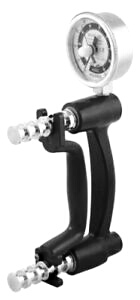A dynamometer with “adjustable hand spacing” was first described by Bechtol (1954), and the earliest mention of it in connection with physical therapy was a study about grip strength in physical therapy students in 1975.
One of the most prolific authors in the field has been American physical therapist Dr Richard W Bohannon, who has published over 60 articles about hand-grip dynamometry from as early as 1986. However, those articles represent a small fraction of the total literature volume about hand grip measured by a dynamometer that has over 3,000 articles.
Whilst a JAMAR brand or other type of hand-grip dynamometer has been a core item in physiotherapy clinics since at least the 1980’s, it is by no means exclusive to physiotherapy. The measurement of grip strength has turned out to be of wide-ranging importance because of having normative reference values, and because it is associated with general muscle strength. Grip strength measured using dynamometry also relates to bone mineral density and to type 2 diabetes.
Moreover, a hand-grip dynamometer is simple to use. Most devices are easily understood and used by people with even modest strength, and all that is required to obtain a measurement is to ask the patient to squeeze it as hard as they can for a short time. Thus, a hand-grip dynamometer can help a physical therapist infer a lot of reliable and useful information about a patient very quickly.
Description provided by KE Norman of Canada
References:
Bechtal CO. 1954. Grip test; the use of a dynamometer with adjustable handle spacings. Journal of Bone and Joint Surgery American Volume, 36A(4), 830-4.

